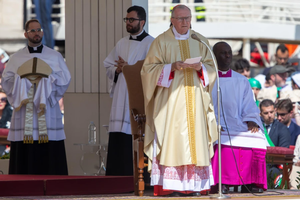St. Alphonsus Rodriguez, Pray for Us!
SAINTS & ART: Known as a doorkeeper, St. Alphonsus Rodriguez drew countless to Christ with his quiet holiness and his profound spiritual vision.

When we speak of saints on the Church’s “calendar,” the truth is that there are multiple calendars to consider. Some saints, like St. Francis on Oct. 4, are recognized as having such significance for the Church that they are celebrated worldwide. Others, like Bl. Marie Durocher on Oct. 6, are significant for a particular country, e.g., Canada, and so appear on the national addendum to the Roman Calendar. And some saints, like today’s Alphonsus Rodriguez, appear on the calendars of particular religious orders, likely more observed in their native countries and in parishes belonging to that religious congregation.
St. Alphonsus was a Jesuit brother born in Spain in 1533, in the generation of the first Jesuits. Peter Faber, one of the first Jesuits, actually prepared Alphonsus for his First Communion.
Alphonsus came from a prosperous home, his father a wool merchant. His father enrolled him in the Jesuit school at Alcalá but his studies were interrupted when his father died and he had to take over the family business. He married at 27 and had three children but, like in the case of Job, they all died. Then taxes destroyed his business.
In his distress, Alphonsus turned to the Jesuits, where he deepened his spiritual life. Although he asked to be ordained a priest, the Society decided he was too old, of infirm health and insufficiently educated. Recognizing his holiness, however, they accepted him as a brother and began his novitiate at age 37.
He was sent to Palma Majorca to be the doorkeeper of the Jesuit college there. Like St. André Bessette five centuries later at the Holy Cross Brothers house in Montréal or Blessed Solanus Casey with the Detroit and New York Capuchins, Alphonsus brought countless people to the Lord by his humble ministry as porter. As evidence, consider he was responsible for convincing St. Peter Claver, then a student in that Jesuit college, to take up the ministry of “slave to the slaves” being trafficked in Colombia. Thanks to the quiet counsel of 72-year-old Brother Alphonsus, Peter Claver found his calling. As Brother Alphonsus put it, he saw every person who came to the door as God. Loneliness is hardly a phenomenon of our times, and Brother Alphonsus extended a listening ear to countless people who came to his door with their physical and spiritual impoverishment. He died Oct. 31, 1617. Although declared venerable in 1626, he was only canonized in 1887, in part because of the vicissitudes of the Jesuits (their suppression) in the 18th century.
Brother Alphonsus cultivated a rich and deep spiritual life — something that became even clearer posthumously when his notes and reflections were published. That spiritual life was also mystical, with Brother Alphonsus favored by many visions of the Lord, Our Blessed Mother, and the saints.
The Spanish Baroque painter Francisco de Zurbarán (1598-1664) had already painted by 1630 one of St. Alphonsus’ visions. The large (8 feet by 5 feet) oil painting, originally in the Jesuit house in Seville, is now in a Madrid museum. The painting depicts a vision of Jesus and Mary, surrounded by cherubs, with an angelic quartet on a slightly lower cloud (indicative of humility) to the right, providing musical accompaniment. The two principals hold the Sacred Heart of Jesus and the Immaculate Heart of Mary, devotion to which was growing at the time and would be promoted by the Jesuits.
St. Alphonsus, in Jesuit habit and accompanied by an angel (his guardian angel?) appear below them. Like in the Transfiguration, two realms or orders coincide — the earthly and heavenly, the temporal and eternal. Most commentators remark about the “split-level” or “two-tier” aspect of the painting, which perhaps is necessary for us to conceptualize Brother Alphonsus’ vision. But Alphonsus is facing us enraptured, not just because we can then better identify him than if he was in profile, but because — again, as one commentator noted — the vision is not so much “somewhere” as in him (just as Beatitude is more a “state” than a “place”). Clouds are not just “heavenly” accoutrements — from biblical times, clouds are signs of the Divine Presence (shekinah) that both reveals and yet keeps man’s eyes from the unshielded vision of God upon whom mortal man cannot look. As is typical both of Baroque painting in general and Zurbarán in particular, chiaroscuro — the masterful use of shadow — is prominent in the painting, especially in terms of setting off the earthly realm from the heavenly.
The Church begins October with the Memorial of the Guardian Angels Oct. 2. If the angel next to St. Alphonsus is his guardian angel, it’s an appropriate ending to the month. Also often during October in Sunday Lectionary Year B (the Gospel of Mark we read this year on Oct. 13), we hear the account of the rich young man whose reliance on his wealth impeded his ability to follow Jesus unreservedly. Brother Alphonsus, who lost everything in his late 20s, found instead the truth of Jesus’ promise: “There is no one who has given up house or brothers or sisters or mother or father or children or lands for my sake and for the sake of the Gospel who will not receive a hundred times more now in this present age: houses and brothers and sisters and mothers and children and lands, with persecutions, and eternal life in the age to come” (Mark 10:29-30).
- Keywords:
- saints & art
- st. alphonsus rodriguez

















